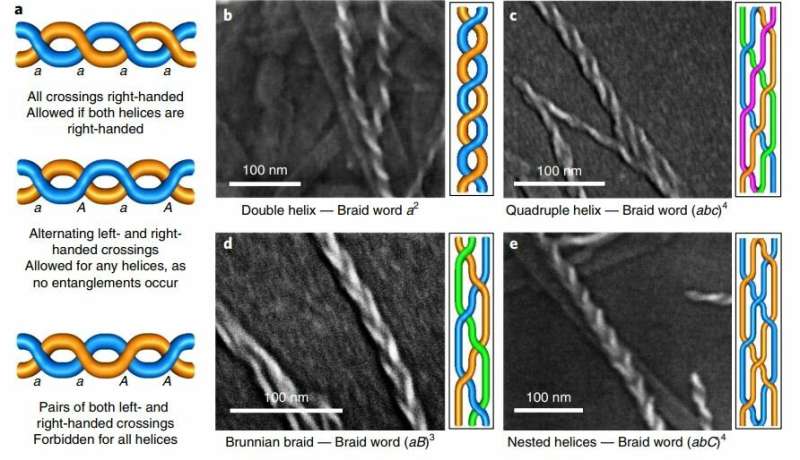March 5, 2019 report
Protein chains that self-form into helical braids

A team of researchers from Durham University in the U.K. and Shaanxi Normal University in China has discovered a type of protein that forms naturally into two main types of helical braids. In their paper published in the journal Nature Chemistry, the group describes extracting an achiral oligo peptidomimetic compound from a urine sample and observing its unique properties.
Prior research has shown that proteins can form themselves into interesting shapes because they develop naturally into chains. Scientists have also learned that the shape a chain takes depends on its amino acid sequence. The study of protein shapes assumed great importance in recent years after it was found that misfolding can lead to conditions such as mad cow disease, in which amyloid fibers form braids and clump together, causing neural damage. The formation of amyloid fibers is also a hallmark of Alzheimer's disease. In this new effort, the researchers took a closer look at a protein that exists naturally in urine to learn more about its shape characteristics.
The researchers found that the protein naturally takes on one of two main types of shapes—one is a four-strand braid in a quadruple helix, and the other consists of pairs of double helices that weave themselves together into a single strand.
The researchers found that aggregating the helices resulted in the formation of braided fibrils. They also found that branching occurred in the braids when errors cropped up, resulting in the formation of intricate patterns of connected braids. They also discovered that mixed-chirality helices assembled themselves into complex braid formations, but sometimes formed bundles if they underwent chirality inversion.
They also noted that the protein chains were very sensitive to chiral amplification, which makes them good candidates for creating gels. The researchers created a gel using these chains in their lab, and report that it was similar in some respects to other gels already used in pharmaceuticals They also report that the gel is stickier than those typically used in pharmaceutical applications, which might make them good candidates for new applications. They also point out that the way the braids are formed can be engineered, which means it should be possible to create gels with different characteristics.
More information: Christopher D. Jones et al. Braiding, branching and chiral amplification of nanofibres in supramolecular gels, Nature Chemistry (2019). DOI: 10.1038/s41557-019-0222-0
Journal information: Nature Chemistry
© 2019 Science X Network




















